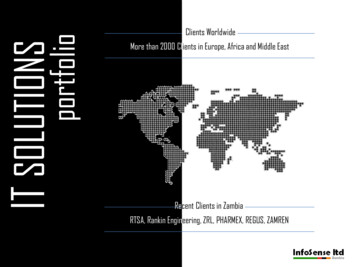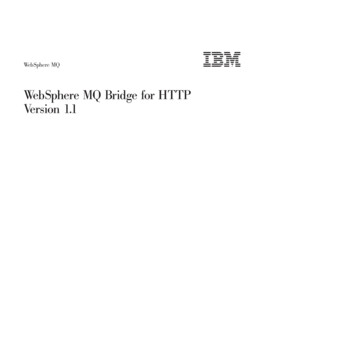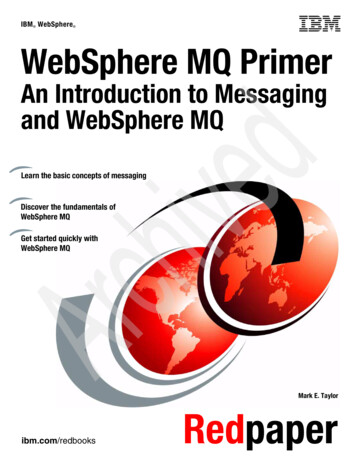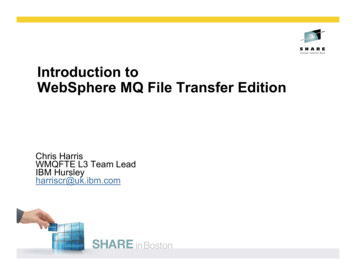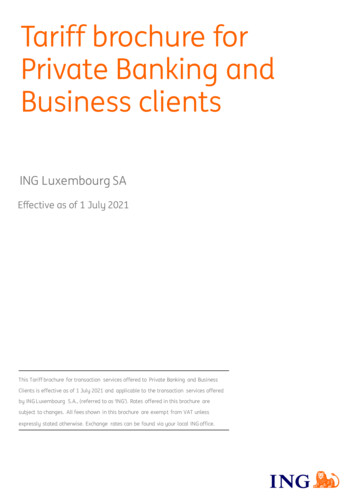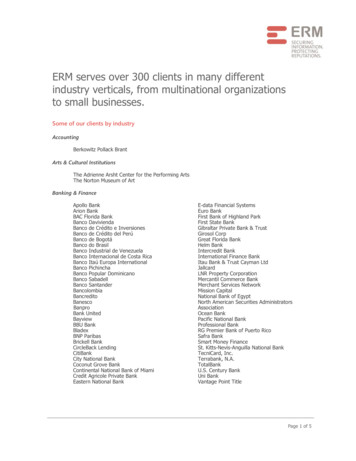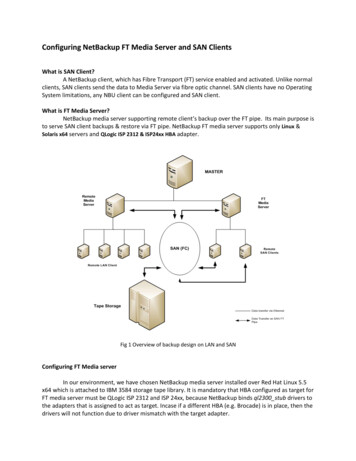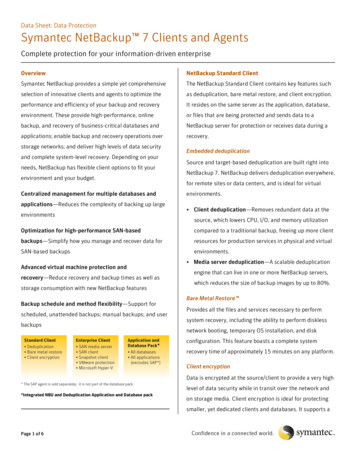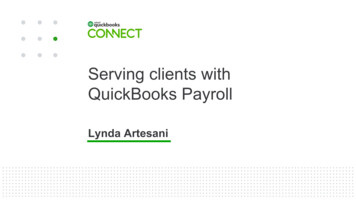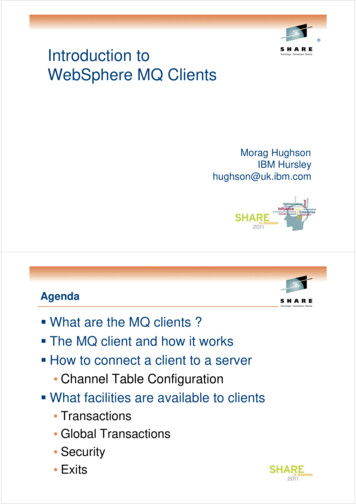
Transcription
Introduction toWebSphere MQ ClientsMorag HughsonIBM Hursleyhughson@uk.ibm.comAgenda What are the MQ clients ? The MQ client and how it works How to connect a client to a server Channel Table Configuration What facilities are available to clients Transactions Global Transactions Security Exits
What is a client ? Allows access to messaging API on adifferent machine than the queue manager Simpler administration Same programming capabilities (almost) CheaperMQMQQueueQueueManagerManager Free in most cases However.NoNo networknetwork –– NoNo licationWhat is a client ? In this world of client/server architectures, thin-clients, thick-clients and networkclients the word client is a much overused word which means different things todifferent people.NOTES For the purposes of this presentation a ‘client’ is merely an application which isissuing messaging APIs but there is a network connection between it and the queuesand/or destinations. In most cases this means the client application is on a different physical machine thatthe server hosting the queues/destinations but this is by no means mandatory. It isperfectly legal, and sometimes necessary, to run a client application on the samemachine as the queue manager server. The advantages of using a client architecture is that there is no requirement to haveservers defined and managed on all the outlying machines. An enterprise may wellhave thousands of applications wishing to do messaging but using clients theadministration can be limited to a few well controlled machines. The disadvantage isthat if the network is down for any reason the applications will not be able to connectto the servers and do any messaging. It should also be noted that messaging in aclient applications is generally slower than in a locally connected application.4
Messaging ClientsMQIJMSC, COBOL, PL/1, RPGetcC .NETJavaDirect IP ingMessagingWebSphereWebSphereMQMQWBIWBIEventEvent BrokerBrokerMessageMessage BrokerBrokerXMSCC C#WMQEWMQEWMQE(.NET)Messaging Clients There are a number of messaging clients designed to suit differentenvironments, different programming languages and different programminglanguages.N In the MQ world there are essentially two programming models. MQI JMS (for non-Java languages use XMS)O These programming models are available in a number of languagesT C C E C# JavaS COBOL Etc.6
Which client to use Power of MQI vs Portability of JMS JMS does not tie you to a provider (99% portable) JMS available for non-JAVA languages in XMS XMS is IBM specific though Multiple backend servers required ? Choose JMS/XMS to talk to both WMQ and WPM Communications Protocol SNA, SPX and NetBIOS only support by MQ C Client How important is speed ? C tends to be faster than Java MQI tends to be faster than JMS/XMSWhich client to use For the majority of cases the same application can be written using any of theclients. There are a few exceptions to this where there is a particular functionavailable in only one client For example MQ supports the notion of message grouping whereas JMS doesn’t.NOTES The decision as to which client to use often comes down to which one fits in bestwith the current application environment. For example, if an enterprise codes all ofits applications in Java then clearly choosing one of the Java clients would besensible rather than using JNI to call the C client. The other major decision is what programming model should be used. This comesdown to choosing between the MQI and JMS. The MQI is particular to WebSphereMQ and while it is extremely common and powerful it is not provided by any othermessaging provider. As a consequence porting an application written to the MQI toanother provider would require considerable effort. JMS is the standard way of doingmessaging in a Java environment and, as such, applications written to JMS shouldport easily to another provider. Note, however, than a JMS application on oneprovider can not necessarily communicate with a JMS application on anotherprovider.8
What is an MQ Client ?ServerModelApplicationMQ ServerLibraryInter processCommunicationsMQServerlocal or bindings modeClientModelApplicationMQ ClientLibraryNetworkCommunicationsMQServerWhat is an MQ Client ? The WebSphere MQ Client support is part of the WebSphere MQ productthat can be installed and used separately from the MQ server. It provides aset of libraries which can be linked with your applications to provide accessto WebSphere MQ queues without requiring the application to run on thesame machine as the queues.NOTE Generally speaking an application is linked either with the client libraries orwith the server libraries (often called ‘local’ or ‘bindings’ mode). In bindingsmode the application communicates with the Queue Manager via an interprocess communications link of some kind. In client mode the applicationcommunicates via a network connection. However, as can be seen from thediagram, the two models are logically equivalent. For this reason thefunctionality provided at the client is almost identical to that provided bylocal applications.S For further explanation please see Chapter 1. Overview of WebSphere MQclients in the WebSphere MQ Clients manual. This presentation containsreferences to further chapters in the Clients manual.10
How does a client work ?MQ Server Requires network access Each MQI Call shipped to server Response returned to applicationMQI ChannelMQ ClientLibraryApplicationMQI EMQPUT1MQCTLMQSETMQBACKMQDISCMQSUBMQGETHow does a client work ? An application that you want to run in a WebSphere MQ client enviromentmust first be linked with the relevant client library.NOTES All the standard MQI functions, except MQBEGIN, are available to clients.The key MQI call at this point is clearly MQCONN(X). It is this call whichdetermines either directly or indirectly which Queue Manager the applicationwill try to connect to. We’ll cover this in more detail later – let’s assume thatwe manage to connect to a Queue Manager somewhere. As the application issues each MQI call, MQ client code directs the requestto the queue manager over the communication link. The MQI request isessentially serialised, sent over the communications link. The serverreceives the request and issues the request on behalf of the clientapplication. It then send back a reply to the client. The surrogate application issuing these requests on behalf of the client is arunning channel of type SVRCONN. Each remotely connected client willhave a SVRCONN channel running on its behalf. It is possible to have manythousands of these channels running into a single Queue Manager.12
How to install a client1. Install a MQ client and MQ server systemInstall MQ server using the SERVER CD ROMInstall the MQ client using the CLIENT CD ROM2. Install MQ client and server on the same machineInstall MQ server from SERVER CD ROMand select MQ clients you wish to install3. Install MQ client from SupportPacs siteDownload SupportPacExtract and run installation programSee WebSphere MQ Clients manualfor platform specific detailsHow to install a client See Chapter 3. Installing client components from WebSphere MQ products andVersion 5 MQSeries products (not z/OS) WebSphere MQ Version 5 products (not z/OS) include easy installation feature thathelps install MQSeries clients quickly.N If you're using WebSphere MQ for z/OS or another WebSphere MQ product, seeChapter 4. Installing WebSphere MQ clients with other MQSeries products.O WebSphere MQ SupportPacs can be downloaded fromT General Index https://www-304.ibm.com/support/docview.wss?uid swg27007197E MQC7 – MQ V7 Clients https://www-304.ibm.com/support/docview.wss?uid swg24019253 MQC6 – MQ V6 ClientsS https://www-304.ibm.com/support/docview.wss?uid swg24009961 MQC5 – MQ Client for VSE https://www-304.ibm.com/support/docview.wss?uid swg24010051 MQC4 – MQ Client for OpenVMS https://www-304.ibm.com/support/docview.wss?uid swg2400903114
What about Licensing ? Installable clients can be downloaded forfree Available on many platforms Client attachment feature requiredfor z/OS Extended Transactional (XA) Clients arenot freeWhat about Licensing ? The Client Attachment Feature for z/OS is chargeable. In MQ V7 5 Administration client connections, for example for use by MQExplorer, are allowed for freeN Extended Transactional (XA) Clients are also chargeable.OTES16
Building a client application Compile your application as you would for local application Make sure you link your application with CLIENT libraries libmqic* for "C" applications on UNIX systems mqic32.lib for "C" applications on Windows imqb23* imqc23* for "C " applications Take care when linking threaded programs e.g. libmqic r.a for AIX Ensure that the correct runtime libraries are available e.g.mqic32.dll for WindowsBuilding a client applicationNOTES MQ Client applications are essentially the same as normal, locally boundapplications. The source and therefore the object deck is identical. Thedecision as to whether to run as a client is normally made at link timedepending on whether the application is linked with the client or serverlibraries. Some applications delay this decision still further until run time. Bydynamically loading the server or client library at run time the sameapplication program can run either in client or server mode depending onthe environment settings at run time. It is even possible for the sameapplication to run both as a local application and a client at the same time ! (an example of this is SupportPac MO71). For further information see See Chapter 11. Building applications forWebSphere MQ clients18
How to connect a client to a server The client must be able to identify which channel it should use tocommunicate with the queue manager How to specify the client's connection to a queue manager: Explicitly on the MQCONNX verb MQSERVER variable Client channel tables Java client programs use either the MQEnvironment Java class orJNDI (using JMS)ApplicationCLNTCONNMQI CallsClient machineSVRCONNServer machineHow to connect a client to a server A channel is a logical communication link (see the WebSphere MQIntercommunications manual). Clients communicate with a server usingchannel called a client connection (CLNTCONN). On the server there mustbe a server connection (SVRCONN) channel available to connect to.N The client identifies which channel should be used when the applicationissues an MQCONN/MQCONNX call.O The choice about which channel to use is made by checking the following (inthis order):T The ClientConnOffset or ClientConnPtr in the MQCNO structure (if an MQCONNX was issued). The MQSERVER environment variable.ES The client channel definition table. This can be found as described by the MQCHLLIB andMQCHLTAB environment variables or using the Active Directory on Windows. The channel definition table found in the default path. Java clients don't use the above method. The standard MQ java classes usethe MQEnvironment class to identify the channel, while JMS clients use theJava Naming and Directory Interface (JNDI) to identify channels.20
Configuring the client Environment variables can be used to configure the way theclient works:ƒMQSERVERdefines a minimal client channelƒMQCCSIDoverrides the client machines CCSIDƒMQCHLLIBPath to the directory containing the client channeldefinition tablecan point to a shared driveName of the file containing the client channeldefinition table (default: amqclchl.tab)ƒMQCHLTABƒMQNAMEspecifies the local NetBIOS name of the clientƒMQSSLKEYRspecifies the location of an SSL key repositoryConfiguring the client See Chapter 9. Using the WebSphere MQ environment variables Not all the available environment variables are listed.See the above chapter for descriptions of variables used less often.NOTES22
Using the MQSERVER variable The easiest way to define a client channel. BUT has default CLNTCONN properties, eg 4Mb MAXMSGLEN Takes precedence over channel tables but is superseded by the use of the MQCNO structure. set MQSERVER ChannelName/TransportType/ConnectionName In Windows: use Control Panel - System - Advanced - Environment Variables In UNIX: export MQSERVER Examples: MQSERVER SYSTEM.DEF.SVRCONN/TCP/127.0.0.1MQSERVER SYSTEM.DEF.SVRCONN/TCP/127.0.0.1(1415)MQSERVER ERVER SYSTEM.DEF.SVRCONN/LU62/BOX99Using the MQSERVER variable See Chapter 9. Using WebSphere MQ environment variables Using the MQSERVER has the advantage that a client channel definition does nothave to be created on a server and then the client channel table distributed asrequired.N However, MQSERVER cannot be used if more advanced options are required on thechannel (such as SSL) and the variable has to be set on each client machine.O A SERVER side channel still needs to be defined (a SVRCONN channel).T Channel name is case sensitive and it names a SVRCONN type channel.E Certain channel options are assumed e.g. MAXMSGL is preset to 4MB.S Use upper case for the transport type (TCP, LU62, NETBIOS, SPX). If you don’t you’ll get a 2058 reason code on the connect ConnectionName is IP address, host name or partner LU name (or destination)24
Channel definition tables A channel definition table is: A binary file (not editable by a user) Created by RUNMQSC (or other MQ mechanism) asAMQCLCHL.TAB (by default) when client channels are defined Use CSQUTIL MAKECLNT function on z/OS Located in directory (by default): mq root \qmgrs\QMGRNAME\@ipcc (Windows) mq root/qmgrs/QMGRNAME/@ipcc (UNIX) Read by the client if no MQSERVER variable defined andMQCONNX options are not usedChannel definition tables See Chapter 8. Using Channels Never remove the channel definition table from its default location; alwayscopy it.NOT You cannot append channel definition tables together. If you want to definemultiple client connection channels then you need to define all the channelson one of the servers. Channel definitions can be shared by more than one client. In other words,the client definition table can be located on a file server.ES To make a client channel definition table on z/OS you use the CSQUTILMAKECLNT function. For details see z/OS System Administration Guide.26
How do I create and deploy a channel table ?RUNMQSCdef chl(.) chltype(clntconn) .AMQCLCHL.TAB mq root \qmgrs\QMGRNAME\@ipcc (Win) mq root /qmgrs/QMGRNAME/@ipcc toz:\mytable.tblMYTABLE.TABHow do I create and deploy a channel table ?NO Choose one of your MQ server machines to define all your CLNTCONNdefinitions. Find the AMQCLCHL.TAB file and copy it to a location which isaccessible by the client machines. The name of the file can be changed ifrequired but you must use the MQCHLTAB environment variable to MQwhat you called it. By default, the client looks for the AMQCLCHL.TAB file inUnix: /var/mqmWindows: \ mq data root TES Environment variables, MQCHLLIB and MQCHLTAB, can be used toenable the clients to locate the channel table See Chapter 12. Running applications on WebSphere MQ Clients.28
Using Channel Definition Tables: Example 1 How is the QMNAME client channel attribute used? def chl(chl1) chltype(clntconn) trptype(tcp) conname(host1) qmname(mars) def chl(chl2) chltype(clntconn) trptype(tcp) conname(host2) qmname(venus)MQCONN ("venus",hConn,cc,rc );venuschl2AMQCLCHL.TABMQ Clientmarsconnected via channel chl2 to “venus"Using Channel Definition Tables: Example 1 In this example the user has defined two client channels.NOTES The client searches through the client channels in alphabetical channel name order. Itlooks for a channel definition with a QMNAME field which matches what theapplication specified on the MQCONN call. We therefore find channel ‘chl2’. If we didnot find any channel definitions which match the application would receive a 2058(Queue Manager name error) reason code. The transmission protocol and associated connection are extracted from the channeldefinition and an attempt is made to start the channel to the machine identified(venus). In order for the connection to be successful clearly there must be startedlistener at the remote machine and the queue manager itself must be started. If the connection can not be established then a 2059 (Queue Manager not available)reason code is returned to the application. If you believe the Queue Manager isrunning then look in the client error log for an error message explaining the reason forthe faliure. The error log is in mq install path \errors\AMQERR01.LOG30
Using Channel Definition Tables: Example 2 Multiple routes to the same Queue Manager def chl(chl1) .trptype(tcp) conname(host1)qmname(mars)def chl(chl2) .trptype(tcp) conname(tokenring) qmname(venus)def chl(chl3) .trptype(tcp) conname(ethernet) qmname(venus)def chl(chl4) .trptype(tcp) conname(dialup)qmname(venus)chl3MQCONN ("venus",hConn,cc,rc );venuschl2AMQCLCHL.TABMQ Clientmarsconnected via channel chl3 to “venus"Using Channel Definition Tables: Example 2 In this example there are three channels, that all connect to the same queuemanager using different connections (ethernet, tokenring and dialup). Thisprovides a level of redundancy.NO The client has to pick one, but which one? The client attempts to start channel 'chl2' (since the search is in alphabeticalchannel name order); its QMNAME attribute matches the name in theMQCONN. However the communication link is currently broken.TE Channel 'chl3' is now started instead because QMNAME still matches whatwas specified on the MQCONN call.S So the client is connected to queue manager “venus" but via ethernet.32
Using Channel Definition Tables: Example 3 How do we have back-up Queue Managers ? def chl(chl1) .trptype(tcp) conname(ip.mars) qmname(planet)def chl(chl2) .trptype(tcp) conname(ip.venus) qmname(planet) .def chl(chl5) .trptype(tcp) conname(ip.pluto) qmname(planet)MQCONN (“planet",hConn,cc,rc );marsvenusAMQCLCHL.TABMQ ClientplutoTHIS DOESN’T WORK (quite!)Using Channel Definition Tables: Example 3 In this example the client tries to connect to a queue manager first using"chl1" but the communication link is down. Secondly it tries "chl2" but the queue manager is not currently running.N Finally the client tries to connect using channel "chl5". The communicationslink is running and the queue manager is running.OTES However, the name of the queue manager "pluto" does not match the onespecified on the MQCONN call “planet” and so this connection fails. There are no remaining client channel definitions and so the MQCONN callfails with reason code MQRC Q MGR NOT AVAILABLE. What we need is a way to tell MQ that we, the application, don’t really carewhat the actual Queue Manager name is.34
Using Channel Definition Tables: Example 4 How do we have back-up Queue Managers ? def chl(chl1) .trptype(tcp) conname(ip.mars) qmname(planet)def chl(chl2) .trptype(tcp) conname(ip.venus) qmname(planet) .def chl(chl5) .trptype(tcp) conname(ip.pluto) qmname(planet)MQCONN (“*planet",hConn,cc,rc );marsvenusAMQCLCHL.TABMQ ClientThis works !Notice the ‘*’ preceding the Queue Manager nameplutoUsing Channel Definition Tables: Example 4 This example is only different to example 3 in that the user has specified"*planet“ rather than just “planet”.N The * specifies that the client does not care if the actual name of the QueueManager does not match the name given.OTES36
Using Channel Definition Tables: Example 5 How do we have back-up Queue Managers ? def chl(chl1) .trptype(tcp) conname(ip.mars) qmname()def chl(chl2) .trptype(tcp) conname(ip.venus) qmname() .def chl(chl5) .trptype(tcp) conname(ip.pluto) qmname()MQCONN (“ ”,hConn,cc,rc );ma
What is an MQ Client ? The WebSphere MQ Client support is part of the WebSphere MQ product that can be installed and used separately from the MQ server. It provides a set of libraries which can be linked with your applications to provide access to WebSphere MQ queues without requiring
